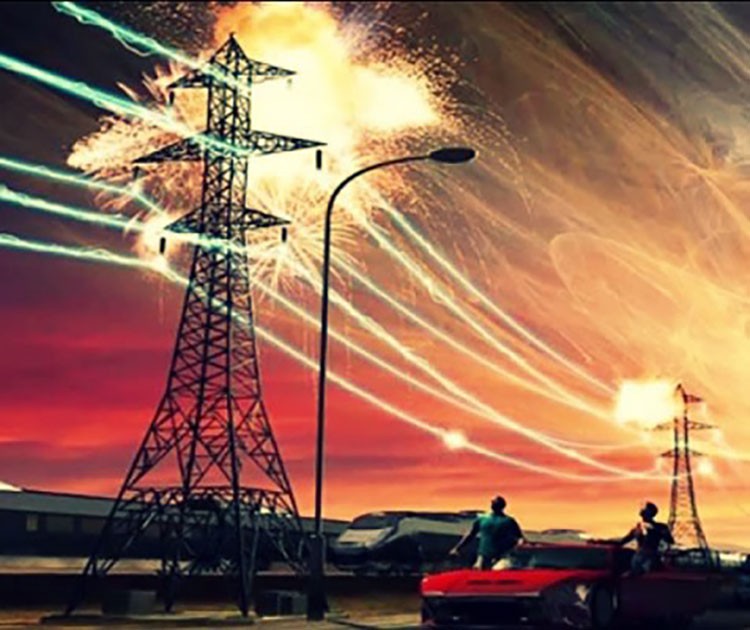
The threat of an EMP is real. If you want EMP protection for home, you need to look at what exactly an EMP might do and what areas of your house it might impact. But first…
Table of Contents
What is an Electromagnetic Pulse (EMP)?
EMPs are short but power bursts of electromagnetic energy. There are different types of EMPs, and they can be from natural or man-made events. Some examples:
- LEMP – Lighting Electromagnetic Pulse
- Meteoric EMP – results from the impact of a meteoroid
- CME – Coronal Mass Ejection – ejected from the solar corona and released into the solar wind
- NEMP – Nuclear Electromagnetic Pulse – resulting from a nuclear explosion high in the sky designed to wreak havoc on a society’s electrical infrastructure
The most well-known example of an EMP is the Carrington Event, also referred to as the Solar Storm of 1859. That was a coronal mass ejection that hit Earth 17.6 hours after a massive solar flare erupted on the sun. Telegraph systems all over Europe and North America failed, in some cases sending out electric shocks. Telegraph pylons also threw sparks. Those who were out at night witnessed a massive display of auroral lights.
Why is an EMP So Dangerous?
If a solar storm the magnitude of the Carrington Event hit the Earth today, the impact would be nothing short of devastating. Modern society is exceptionally dependent on the electrical grid. There would be an indefinite blackout. Everything from our communications, banking, and food/product delivery systems rely on a constant connection to the grid. When that inevitably fails – TEOTWAWKI.
Nations (think North Korea, Russia, and China) have reportedly worked on the capacity to detonate a nuclear device high in the sky. While this wouldn’t have the impact of a typical ground detonation, it would create an EMP, likely causing far more devastation than if it had detonated on impact with the ground.
The impact could disrupt, or even destroy, electronics from miles away. A congressional report even details how a North Korean EMP would cause starvation. It would cripple the U.S. economy and severely weaken our military.
If you want more specifics on the impacts of an EMP would have, see the Report of the Commission to Assess the Threat to the United States from Electromagnetic Pulse (EMP) Attack. That report details the many ways an EMP could cripple the United States.
How Do You EMP Proof Your House?
There are three ways you can get emp protection for home and family. The first two are probably quite obvious to most people who have been prepping for any length of time. The third is a level of protection that is house-specific.
1. Take Standard Preparedness Measures
Everything you do to protect your family from natural catastrophes, job loss, pandemics, war – that will all help protect you from an EMP as well. If the grid goes down, and you have wood heat as a backup, that heat will keep your family warm regardless of the cause for a power outage.
The same goes for food and water storage. If you want food stored so you don’t have to go to the grocery store when a pandemic strikes, that same food will serve you well should an EMP hit and there is no food at the grocery store. Prepping principles apply (almost) equally across different SHTF scenarios, and an EMP is no different.
The biggest difference in preparing for an EMP versus something like a natural disaster is the length of time on the other end. With a natural disaster, resources are mobilized to help the impacted areas. Relief is in sight. Neighbors help neighbors. With an EMP, however, the impact would be much greater – and longer lasting. Neighbors could stop helping neighbors. Neighbors could start turning on neighbors.
2. Build (or Buy) Faraday Cages
A Faraday Cage is a metal box designed to protect any items inside from an EMP attack. You can make Faraday Cages from old microwaves, metal filing cabinets, etc. It’s also as easy as wrapping a cardboard box in aluminum foil, as shown in this YouTube video.
Alternatively, you can buy a Faraday bag or buy Faraday fabric. Obviously these are smaller products that are not designed to offer full EMP home protection. What they do do, however, is protect vital pieces of electronic equipment.
Does your house really need full EMP protection if – we assume – an EMP attack would destroy the entire grid? In that case, the power isn’t coming back on for a long, long time anyway – what’s it matter if your fridge is protected?
What might be more important is protecting things like ham radios, cellphones, laptops, electronic medical equipment, etc. This is where smaller Faraday cages come in. Mission Darkness has many off-the-shelf products to choose from if you don’t want to build your own.
3. Purchase and Install Whole House Surge Protection
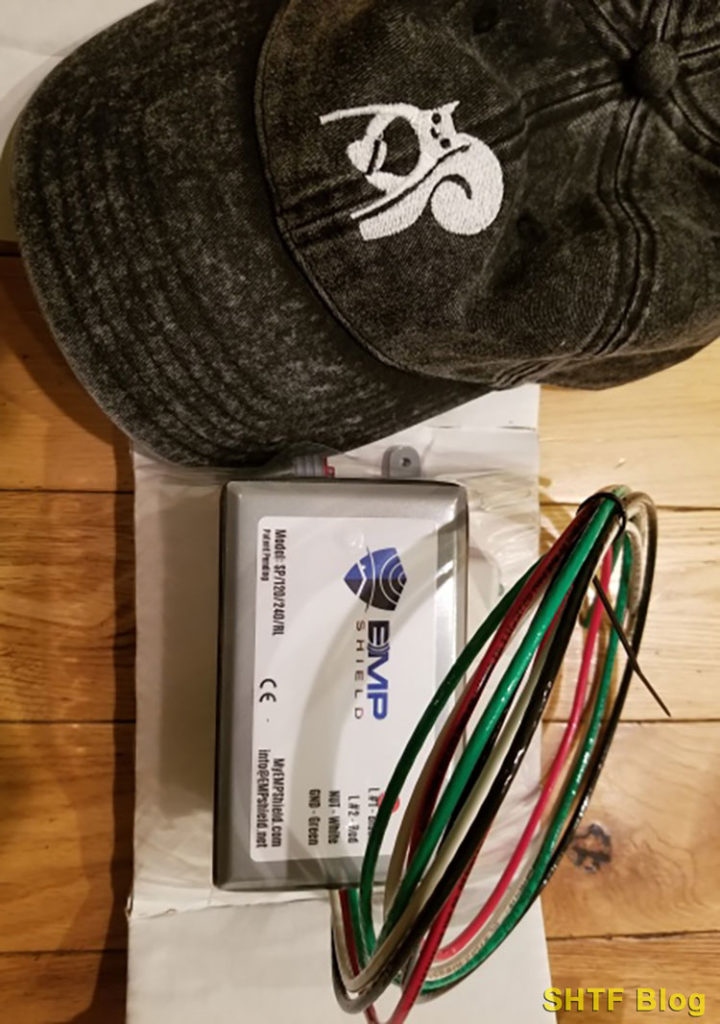
The third way to EMP proof your home is through a whole house surge protector. This is a small device built to military standards (usually) but available for public purchase. It bills itself as “a very robust electrical surge arrestor, designed to exceed the requirements of MIL-STD-188-125-1 for shunting over-voltage spikes to the ground and neutral very quickly.”
Technical mumbo jumbo? Let me help. The “MIL-STD-188-125-1” is military standard (minimum requirements) “for high-altitude electromagnetic pulse (HEMP) hardening of fixed ground-based facilities that perform critical, time-urgent command, control, communications, computer, and intelligence missions” as stated in the pertinent military document.
In other words, it’s the standard by which the U.S. military sets to protect electrical equipment at fixed locations from the effects of an EMP.
Siemens is well-trusted brand and they also produce a whole house surge protection system, the FS140:
- FirstSurge Surge Protective Devices (SPDs) are Type 2 and UL / cUL 1449 listed, meeting designated protection requirements
- FirstSurge is constructed using our commercial grade NEMA 4X enclosure allowing for indoor or outdoor installations
These products connect to your home’s electrical panel. There it is able to stop an unexpected surge in less than one billionth of a second! The excess voltage is drained away before it can damage any equipment downstream. This adds a whole other level of protection for everything plugged into your home’s electrical system. This includes all types of power surges: EMPs, CMEs, and even lightning.
Interestingly enough, you can buy a similar product to protect your bug out vehicle from an EMP through a 12 Volt DC Vehicle EMP Protection device such as this one from EMP Shield:
- EMP Protection: All Phases an EMP (E1, E2, & E3).
- Lightning Protection: 100% Lightning Guarantee Backed By a $25,000 Insurance Policy.
How to Install
Enough people have asked about how to install this device that I had to add this section. I am not familiar with the install process process but commenters are. What follows is advice from one reader with his photos.
One commenter who goes by Ghostwalker writes:
I would love to see the setup and how it was built, parts, time, and the expense of building one, because I just bought a predator 9,000 watt generator and it’ll run my whole house when power goes out I just got the main breaker, plug in the generator and start it up!! Any little tidbits of info would be greatly appreciated!
“L & R” sent a response detailing what he did.
We hired an electrician to make the connections to our home electrical system. See pics. We attached the EMP device to “2 – 20amp breakers.” Make sure that you are covering each of panel busses. (Each side is 110amps.) Again, see pics.
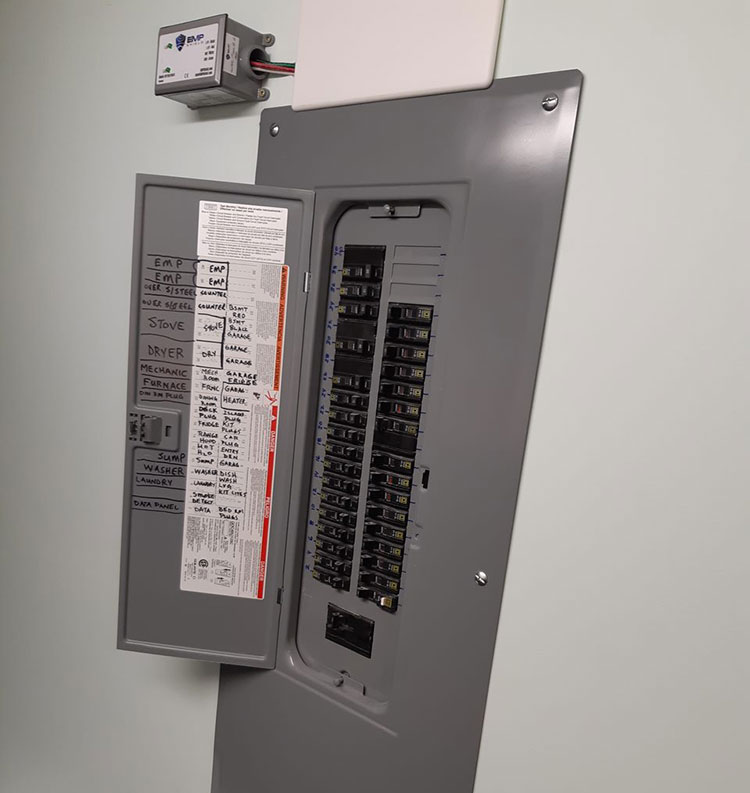
There is a ground, white neutral, and two hot wires which goes to each of the breakers. This system protects the entire household.
The generator runs by gas and a battery. Look for an automotive EMP for your generator battery. Hook it up to protect the generator while it is running and disconnect from power source when not being used. Get a battery tender to act like a trickle charge to keep battery charged.
Make 2 transfer boxes, an automatic or a manual. Both styles need to be installed by a licensed electrician and the hydro meter has to be removed for the installation of the transfer box, the electrician will arrange do that. The automatic transfer box type senses a power outage and will send a signal to the generator to start up. When the power returns, the transfer box will shutdown the generator.
The manual style has to be turned on and off manually. The transfer box has the main electrical line entering in and then exiting into the panel. When a power outage occurs, you have to throw the switch after you start up the generator. When power returns, you have to throw the switch back and turn off the generator.
As for the EMP protector, it will have 4 wires, a green ground, a white neutral, and 2 hot leads. You will need two 20 Amp breakers, make sure that each hot bus line is connected by each breaker. Connect the ground wire to the bare copper wires, the white to the white wires, the two hot ones go into each breaker. If wired correctly, the EMP displayed lights should all light up.
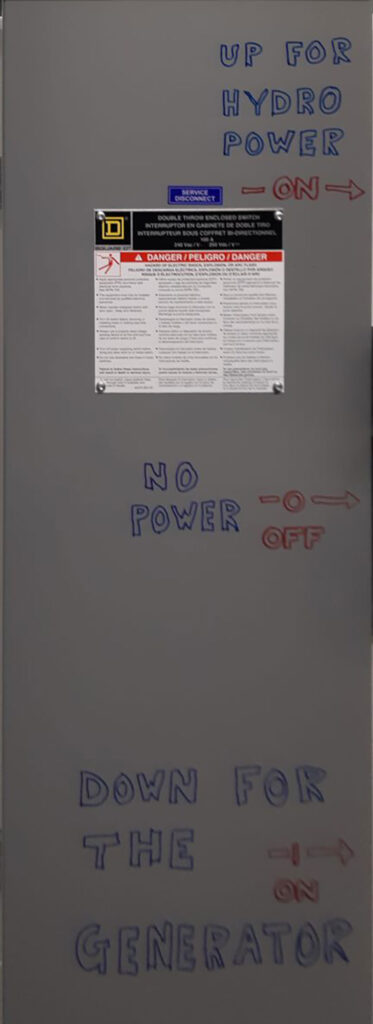
As for the portable generator, you can get the automobile EMP for the battery. The EMP looks like a shotgun shell with 2 wires, one goes to the positive terminal and one goes to the negative terminal.
Also nice to attach a battery tender/trickle charger to the battery, so the battery is always charged. If you use a portable generator and have close neighbors, to quieten the noise level, go to YouTube for ideas on house to make an insulated box for the generator.
EMP Protection for Home is (Somewhat) Easy
Being a prepper puts you way ahead of the game when confronting the challenges resulting from an EMP. Continue standard preps, extending how long you could go without external help, and consider additional steps such as Faraday Cages and whole house surge protectors.

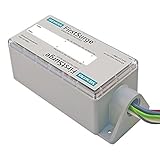

29 comments
NEED MORE INFORMATION ON EMP SHIELD FOR MY ROLL OUT GENERATOR. I ALWAYS KEEP GAS. MY GENERATOR IS WIRED FOR MY WHOLE HOUSE, BUT I NEED SOMETHIMG TO PROTECT IT WHEN I CONNECT IT FROM OUTSIDE.
Hi – I’m not sure how the EMP Shield could help with that. They have an auto version that may or may not work. Have you tried contacting them? I’d also suggested Mission Darkness for Faraday materials that you could use to cover your generator, but if it’s just a simple engine (no electronics), you may be good to go as is.
How can I make those siemen for the house and a couple for the car
I’m not sure.
I have my whole house and garage is hooked up to emp for the roll out generator I have a trap plugged into my generator and I would get the faraday cloth to cover the generator as well or make your own out of a cardboard box and aluminum foil . Also to Disasterprep is the one with seimans you can find him on youtube
How do you connect the EMP shield in an apartment?
You probably can’t unless you have landlord permission.
We bought the Good2Go.ca EMP protector for our home, and since our generator is connected to the house wiring which was done by a qualified electrician, the secondary benefit is; it also protects the generator. I can send a pic if you send a Signal or Telegram or Messenger link to show the set up.
I would love to see the setup and how it was built,, parts,, time,, and the expense of building one,,, because I just bought a predator 9,000 watt generator and it’ll run my whole house when power goes out I just got the main breaker,, plug in the generator and start it up!! Any little tidbits of info would be greatly appreciated!! Thanks in advance,,, sincerely Vernon aka the GHOSTWALKER!!
Ghostwalker, please see the revised article. L&R sent a response that I just incorporated directly as it could help others.
If the entire grid goes out, what good does having a emp protector on your house? The electric co is out, you still wouldn’t have lights or power rt??
It protects the devices in your home. So, theoretically, you could then run those off a generator, solar panels, etc.
As I am quite familiar with how EMP actually works, the potentially destructive energy surge doesn’t just come in through the main line feed to the building. It accesses every single exposed power and data line throughout the structure. So I simply do not understand how a surge protector connected to the breaker box could possibly protect devices, appliances, computers, etc. that are vulnerable because of how they are plugged into wall sockets and networks. Shunting the surge to ground at the breaker box – if that is effective – will not protect connected “targets” with exposed wires and cables that act like antennas/receptors for the EMP.
i agree norvelle, an emp will back feed straight to your sensitive electronics before ever reaching your breaker box or power coming in from the grid.
EMP Shield requires you have a licensed electrician install their devices on the AC side, otherwise they will not honor the warranty. DC they will but not the AC. Very disappointing to find out. An alternative company which seems to have very good products is badwolfusa.com
Thanks for the comment… But I still want to know how it is possible for any company – EMP Shield or Bad Wolf – to offer “whole house protection” against EMP with a device wired into the breaker box. EMP burst doesn’t destroy only by entering a structure through the main power supply, as you must know, it does damage by coupling with internal cords, lines, cables, etc. How does one device protect against that? All I can figure is that there’s some kind of magic involved…NOT.
I’ve asked this same question to a coworker of mine who had an EMP protection device at his residence. He threw his hands up. I still don’t get how this can protect the home from an attack. Makes zero sense.
Dense smoke and broken mirrors, IMHO.
I’ll reach out to the company and see what they say.
Okay, I spoke to EMP Shield for clarification. They said a few things:
1) there are many nuances to EMPs that are misunderstood,
2) some modern electronic devices actually already have built-in protection because they need to protect from IMF (Apple watches as an example),
3) the unit acts as a whole-home surge protector,
4) devices plugged INTO the home’s electrical system are protected because of the device (it extends protection) – i.e., it protects devices even if the pulse strikes outside the electrical lines.
They also referenced their testing: https://www.empshield.com/testing/.
I asked if a company representative could chime in here to answer questions and that request is being moved up the company ladder. In a nutshell, based on my call with the sales person: devices plugged into the home are protected. Some devices NOT plugged in already have built-in protection. Devices NOT plugged in WITHOUT built-in protection are most vulnerable.
Clear as mud?
Anyone who understands physics and basic principles of how electricity and EMP actually work understands that this is a nonsensical answer. Actually a non-answer. It “works” because they say it works in some Harry Potter fashion. The notion that somehow some way in some magical realm the EMP Shield “reaches out” to protect downstream devices is a fairy tale, IMHO.
This is what I pulled from FAQs.
Whether the electrons are collected within your home or are attempting to come into your electrical system from outside the home (the grid), the EMP Shield will see the surge and protect your electrical system. Since the shunting is completed incredibly fast (500 trillionths of a second), the over voltage is pulled away from the equipment before the voltage can rise high enough to damage any equipment. We call this new technology SightSpeed™ and it ensures no heat is generated within the electrical system which protects all electronics connect to the system.
I mean no disrespect to Derrick but I am just not confident in the response you were given by EMP Shield. If I have an air fryer plugged in and an EMP attack occurs I believe that unit will get fried regardless of the EMP Shield installed. If the fryer is protected then any habitat, commercial or residential, with this device installed would be protected? Just seems too easy.
No disrespect taken. I’m trying to sort this out for readers, so all constructive responses are welcome. I did ask that someone from the company come to chime in and answer questions. The salesperson was going to discuss that with staff.
My portable, roll out, 200lbs generator is in a closet in my basement underground (there’s a walkout egress but on the other side of the room). Is the generator still susceptible to an EMP or does the earth and block walls protect it?
It’s probably quite safe. Most generators do not rely much on computer chips or panels. If you have more concern, wrap it in faraday fabric.
Another company which has related EMP devices is www.slientek.net . They also have modules to protect solar panels and vehicles…
How does one know these “whole house” EMP protection devices actually work?
How are they tested to determine their effectiveness? If so, where are the results published and who did the testing?
See my comment above referencing my call with the company.